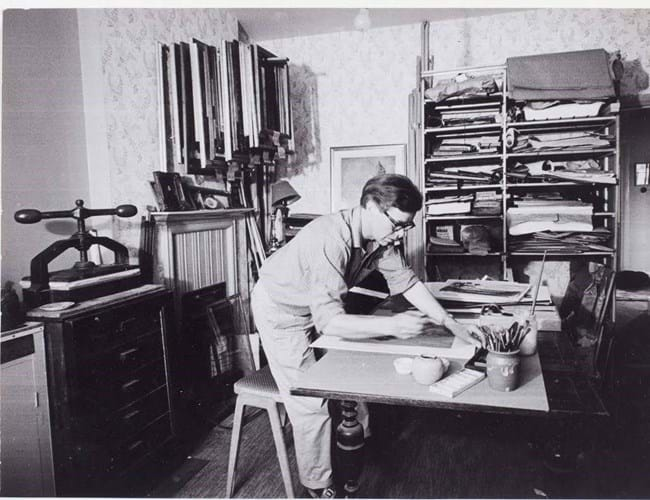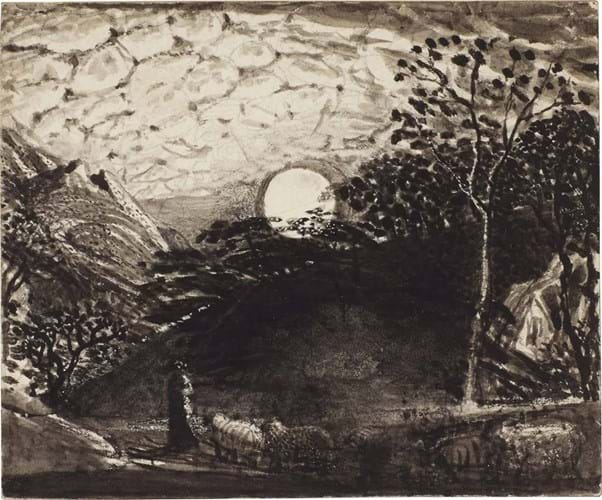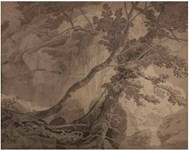The two-part sale of the collection of Cyril Fry (1917-2010) at Sotheby’s and Chiswick Auctions evoked many memories of the well-known art dealer himself.
A specialist in watercolours and drawings for over 50 years, Fry spoke of “the subtle modesty of the medium”. Despite this, he did a huge amount to help such works gain attention and become more fully appreciated.
Born in Forest Gate in east London in 1917, he was the son of a carpenter and left school at 14. Initially working as an office boy and various other jobs (including a spell working for a solicitor who represented the famous dealer Joseph Duveen), he trained as a sign-language teacher and went on to present a BBC TV programme for deaf children.
After 18 years in teaching, his interest in watercolours turned into a profession as he set up a workshop in his Westminster flat where he practised mounting and framing as well as restoring works.
Gallery opened
After then launching out as a fully-fledged dealer, he sold works from the flat and later from his house in Blackheath before then taking a lease on a gallery at 59 Jermyn Street.
Specialising in 18th and 19th century works in particular, Fry and his wife Shirley grew the business and were at the forefront of the rising market in the 1970s-80s, selling works to important collectors such as Paul Mellon and Leonard Duke. The Sotheby’s catalogue stated that “his taste and interests helped shape a whole generation of British collectors in the field”.
The Fry Gallery eventually closed in the 1990s when their lease ended, although Cyril and Shirley continued their operations from Aldeburgh in Suffolk. Shirley’s death earlier this year precipitated the auctions of almost 1000 works in total across the two houses with many pictures unseen since the Jermyn Street gallery had closed its doors.
A smaller group of 72 higher-value lots were offered across two mixed-owner Sotheby’s sales in early July, followed by a much larger and more wide-ranging dedicated sale at Chiswick Auctions on July 9.
The dispersal was very much a collaboration with each of the catalogues mentioning the other saleroom’s tranche of the collection and a shared introduction penned by art journalist Huon Mallalieu.
The Chiswick sale in particular was a recreation of the sort of auctions that Fry would have attended himself, especially early on, where many of the unframed drawings and watercolours were offered in group lots or bundles in folders. This attracted buyers who enthusiastically came to view and rummage through the many works while also brushing past the dealer’s props and furniture that were also on offer.
Suzanne Zack, specialist in charge of the sale at Chiswick, said: “I think both Cyril and Shirley Fry would have appreciated how the sale was presented, complete with plan chests, miniature display easels, book and paper presses, as well as a group of artists’ palettes and paint boxes. The sale featured many group lots of works on paper as well as single items, making it perfect for connoisseurs and dealers alike.”
Palmer comes top
As with the Frys’ dealing philosophy, the sales tended to reflect a focus on quality and artistic interest rather than just ‘big names’. The top lot of the collection, however, was certainly by one of the biggest names in English watercolours: a remarkable work by Samuel Palmer (1805-81) from his celebrated ‘Shoreham period’.
Offered at Sotheby’s (25/20/13.9% buyer’s premium, plus 1% overhead premium) sale titled A Fine Line: Master Works on Paper from Five Centuries on July 7, A Shepherd leading his flock under the full moon was one of the visionary landscapes the young artist produced while living in the rural village in Kent from 1825-35.
Despite their small size, these monochrome pastoral scenes are arguably his most powerful and creative works and, with many now in museums such as the Ashmolean, Tate Britain, the British Museum and the Whitworth Art Gallery in Manchester, they rarely appear on the market. One did appear at the sale of the Howard and Saretta Barnet collection at Sotheby’s New York in January 2018, selling at $2m (£1.4m) and dramatically raising the bar for these pictures.
The current example had been owned by Leonard Duke and given to Fry sometime before the dealer dispersed the works from Duke’s estate following the collector’s death in 1971. It was deemed slightly earlier than the Barnet picture, with the 6in x 7in (15 x 18cm) black watercolour over black chalk dating from c.1829-30.
It was well preserved, although two small artist pinholes were visible at the top corners and the thin card on which Palmer had applied the watercolour had been laid down onto a piece of handmade paper.
The composition was perhaps looser and less finely finished than the Barnet picture but, with bidders clearly aware that opportunities to purchase a Palmer ‘Shoreham’ watercolour likely to remain few and far between, they were prepared to go to similar lengths to acquire this one.
Estimated at £700,000-900,000, it was knocked down at £1.3m – putting it alongside the Barnet watercolour as the only two works by Palmer to have made over £1m at auction.
Another work by a ‘big name’ in the market, a watercolour of a wagon going through Bagley near Abingdon by JMW Turner (1775- 1851) also drew interest among the Fry lots, selling at £68,000 against a £40,000-60,000 guide.
Biffin bird study
Commanding even more attention was a brightly coloured and exceptionally rare study of bird feathers by Sarah Biffin (1784-1850).
The artist was born without hands, arms or feet – she is thought to have had the condition phocomelia – but taught herself to write and paint, holding the pen or brush between her teeth. She has come to greater prominence in recent years although almost every work that has emerged at auction has been a portrait.
The 4 x 6in (10 x 15cm) watercolour was something of a test of the market for a different type of picture. Although Sotheby’s catalogue stated that it displayed “the full extent of her extraordinary talent” with the “soft textures of the feathers rendered in the most realistic way”, the small size and unusual subject no doubt led to the cautious £4000-6000 estimate.
But with the artist’s life and work becoming continually more recognised, the picture drew hefty competition and was knocked down at £52,000. Only the self-portrait of the artist with her easel that made £110,000 at Sotheby’s in December 2019 has fetched more for a work by Biffin (see ATG No 2422).
Perhaps Fry was ahead of the curve in acquiring this diminutive work at a time when prices for the artist were often no more than a few hundred pounds?
At the heart of art
The hammer total from the Fry collection across the two Sotheby’s sales was £1.79m with 63 of the 72 lots sold (88%).
Mark Griffith-Jones, Sotheby’s British watercolours and drawings specialist, said: “It was a great honour to work with such a distinguished private collection put together by a couple who were at the heart of the London art market for such a long period of time.”

















